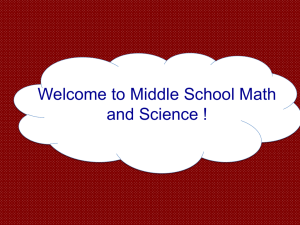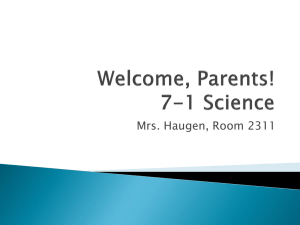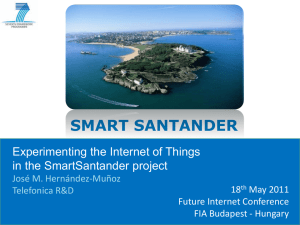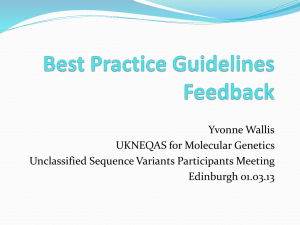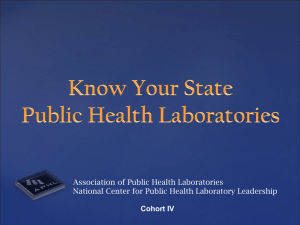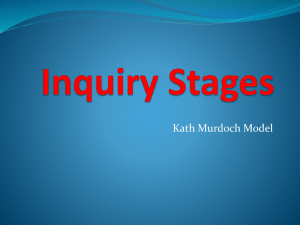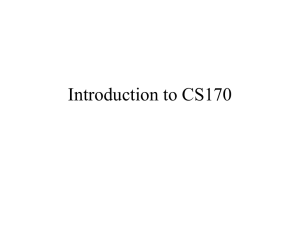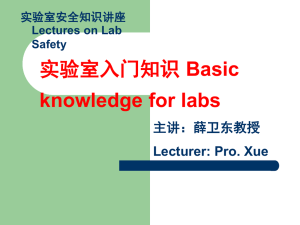PowerPoint Presentation - Lab Education to teach Scientific Thinking
advertisement
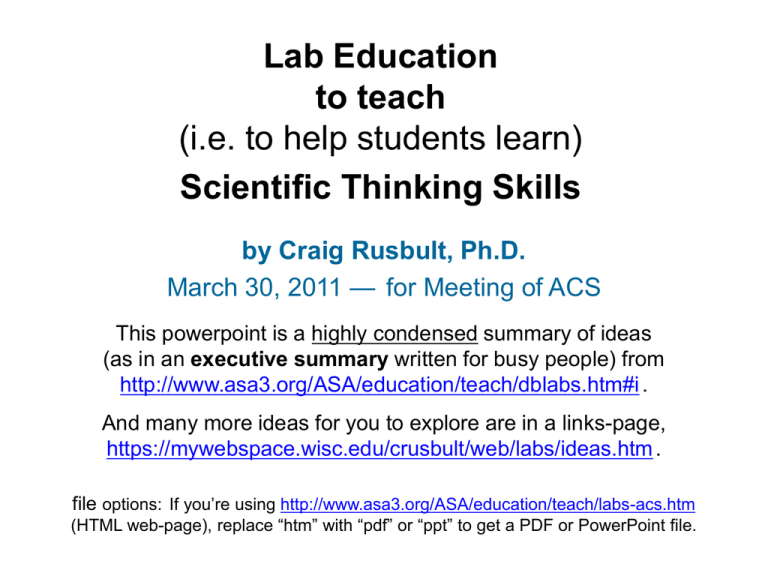
Lab Education to teach (i.e. to help students learn) Scientific Thinking Skills by Craig Rusbult, Ph.D. March 30, 2011 — for Meeting of ACS This powerpoint is a highly condensed summary of ideas (as in an executive summary written for busy people) from http://www.asa3.org/ASA/education/teach/dblabs.htm#i . And many more ideas for you to explore are in a links-page, https://mywebspace.wisc.edu/crusbult/web/labs/ideas.htm . file options: If you’re using http://www.asa3.org/ASA/education/teach/labs-acs.htm (HTML web-page), replace “htm” with “pdf” or “ppt” to get a PDF or PowerPoint file. The Basic Ideas A science lab — where students can do science and think about science — is an ideal place to learn scientific thinking skills. How? • Define Goals for desired outcomes , for the Ideas-and-Skills we want students to learn. • Design Instruction with Thinking Activities to provide opportunities for experience with these ideas-and-skills, and Teaching Methods that help students learn more from their experiences . Three Comments • The Basic Ideas are not original — they are common strategies for good teachers — so, in order to be useful, they must be supplemented with important details. • This is a proposal for potential future work, not a report of what already has been done. • The actions (to get goals & thinking activities & teaching methods) are not sequential steps, they are modes of thinking-and-action, so "reverse inspiration" is possible, common, and often very useful for design. For example, goals can inspire activities (goals activities), and activities can inspire goals (goals activities), as in my page about lab activities for general chemistry, linked-to in https://mywebspace.wisc.edu/crusbult/labs/ideas.htm Thinking Activities Thinking Activities ( = Learning Activities) provide opportunities for high-quality effective experience with the ideas-and-skills that are your educational goals. How can you find thinking / learning activities? • Old Labs — analyze what students are doing now. • Old Labs Revised by adding new activity-experiences, including those outlined in Teaching Methods, and more. • New Labs — invent by self, find in journals & forums, . . . All searching can be guided by your educational goals. And with reversed inspiration, activities you find (in old labs, thinking about teaching methods, in journals/forums) can inspire you to expand-and-revise your educational goals. Teaching Methods Teaching Methods are just another perspective on Thinking Activities (potential Learning Activities), when teaching thinking-and-learning experiences. 1. Reflection Activities — when a teacher directs attention to opportunities for learning, thus moving students from only “going through the motions” to active minds-on awareness, which can help students learn more from their experiences. 2. Student Responses — by talking and/or writing. 3. Evaluation Activities — if responses / actions are graded. 4. Inquiry Activities — when gaps in knowledge (in ideas-and skills) leads to situations where students “don’t know what to do” so they must think, and are allowed to think. 1. Reflection Requests Reflection Requests can be implicit (if an activity automatically requires active minds-on attention) or explicit (if a teacher directs attention to “what can be learned” during an experience that could otherwise be done with little awareness of a learning opportunity). Explicit reflection requests can be useful for motivational persuasion that is done to improve Educational Teamwork when there is a feeling of “us” due to a combination of goal-directed teaching (by teachers) and goal-directed learning (by students), and our goals match their goals. We can achieve closer matching of teacher/ student goals in two ways: by adjusting our goals to match students’ goals , and persuading students to embrace our educational goals . When we try to persuade, we should consider all aspects of total motivation — intrinsic (enjoying an activity), personal (learn ideas / skills to improve our quality of life), interpersonal (impress others), extrinsic (perform for grades) — which are all internal, contributing to what a person wants in their whole life as a whole person. We can try to persuade students of our good intentions (in setting goals that are good for them) and competence (to achieve these goals), with our words (what we say in “pep talks”) and actions (what we do), 2. Student Responses Should we ask students to respond by writing, or talking, or both ? pros & cons of writing: students can improve this valuable skill by practicing it and receiving feedback on how to improve; grading can be difficult, unpleasant, time-consuming; feedback for students is delayed. benefits of talking: can stimulate minds-on awareness during lab (but so can writing); better feedback (immediate & detailed); less tension of “teacher vs judge” (if information is withheld to be fair-to-all for a written response that will be graded, instead of withholding only for pedagogical reasons, to adjust the level of inquiry-difficulty); and compared with grading lab reports, usually discussions are much more fun. the problem of pacing: students often must wait for discussion, due to supply/demand imbalance with one teacher & many students; solutions (supergroups, student-only discussions, productive waiting, improved instructional design & teaching skill) are only partially successful. • Hybrid Labs , with skillfully coordinated talking and writing, combine the best of both: some scheduled discussions, and some writing. 3. Evaluation Activities We do evaluations to test students’ working knowledge: their ideas (what they know) and skills (what they can do). How ? by grading the quality of labwork, responses (written or verbal), online assignments, quizzes & exams, . . . But evaluating higher-level thinking skills can be difficult. Why ? Grades are a useful external motivation for most students. If our evaluations measure appropriate knowledge (the ideas-andskills we have defined as educational goals, and have been teaching) accurately, we can reward students who excel in achieving these goals; and we get feedback about our instruction — if a significant number of students do not improve their ideas-and-skills enough, we can try to improve our instruction. (and maybe also revise our goals) 4. Inquiry Activities I think most of us agree that • inquiry activities can be educationally valuable. • we need to adjust the level of inquiry-difficulty so it’s in a range that is “just right”, as in a skillfully designed mystery story; we can adjust the intrinsic difficulty (what we ask students to do) and the actual difficulty (by preparing students before an activity and coaching them during it). • we should aim for an eclectic blending of direct learning (which can be active-and-meaningful) with inquiry learning. But there can be disagreement about how to use inquiry, about the types of blends that are most educationally effective for achieving different goals (learning ideas, learning skills,...) in different contexts (in labs, lectures, discussions, computer instruction, ...). My ideas for supplementation-and-revision of labs can be used for any approach, for either inquiry labs or “traditional” labs. When evaluating blends, consider an 80-20 principle (if 80% of the total value comes from 20%) due to diminishing marginal benefits. I suggest wise moderation in our use of inquiry. (link is in ...ideas.htm) Integrative Analysis of Instruction is a strategy-tool, developed and used for my PhD project, that is useful for Understanding the Structure of Instruction: Skillful goal-directed coordination of activities (seeing patterns horizontally, vertically, and in other ways) increases their mutually supportive synergism and effectiveness; some activities prepare students for others, and what they learn in early lab experiences is reinforced later. The 8 educational goals are illustrated in labs for general chemistry that (in a page linked-to from .../ideas.htm) are described in 4 sections: Thinking Skills using Observation-and-Imagination, and for Data Analysis; The Logic of Science, and The Logical-and-Social Process of Science. Appendix Here is the main part of my Poster Session for ACS. You can find a web-page with all of the poster-pages (these & more), ENLARGED so you can see all of the details, by using the ideas.htm page whose URL is on the first page of this powerpoint.

